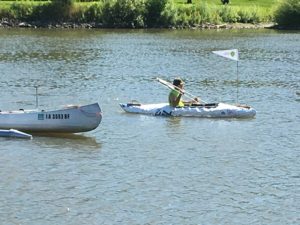Doing Things the Right Way for Waterways

TAKO’s Seize the Carp event with Lon Drake’s recycled materials canoe.
How many times have you looked out over the Iowa River on a hot, sunny day and thought about how nice it would be to go for a dip? Or encouraged your children to frolic in a shallow creek, or let your dog drink from a lake after a tiring hike?
If you’re in Iowa, the answer is probably “not often.” Certainly there are treacherous currents and natural hazards in the waters, but more likely the reservations are related to human-caused pollutants: chemicals from fertilizers and pesticides applied to lawns and crops that are washed into our waterways; manure from ag industry properties; trash and other waste making its way into our streams and rivers. Iowa’s rich topsoil, our agricultural heritage, is lost via erosion at a rate of more than 5 tons per acre a year.
These pollutants can harm the health of humans and wildlife here in Iowa. Witness the numerous beach closings and warnings related to harmful pathogens every year, or periodic fish kills. And the effects aren’t limited to the state that introduces the pollutants into the waterways: everything we do here in Iowa makes its way downstream, even all the way to the Gulf of Mexico, where nutrients from our fields help contribute to the “dead zone” the size of Massachusetts–an area inhospitable to fish and other ocean-going creatures.
Why do we tolerate this state of affairs? We wouldn’t tolerate businesses dumping their waste in our backyards; why do we tolerate them dumping it in our shared waterways? There are proven strategies that can help reduce and mitigate the effect of runoff from fields, including the use of cover crops, buffers, and preserving wetland areas, as well as other practices that would minimize erosion and reduce the amount of harmful materials that find their way into our rivers and streams (the Sycamore Greenway itself is an example of land use designed to mitigate runoff into our waterways, as it diverts runoff from neighborhoods into cells lined with deep-rooted native plants). Many responsible farmers implement them and act as good stewards of their land. But many others do not, as these practices come with a cost that would reduce profits.
In December of 2019, the DNR released its triennial work plan for water quality standards. Unlike the plans of all of our neighboring states, it did not include a plan to adopt numeric nutrient criteria, which would establish specific standards for when a issues need to be addressed instead of the current subjective criteria being the presence of “aesthetically objectionable conditions” and “nuisance aquatic life.” Iowa can and must do better.
Legislators in Des Moines have made noises about finally taking steps to fund the Natural Resources and Outdoor Recreation Trust Fund, which was originally planned to fund a variety of conservation and recreation programs, including REAP and recreational trails. Industry groups, however, are working to adjust the allocation from what voters originally approved to a new formula that would emphasize water quality and nutrient reduction rather than conservation and recreation.
But why then are we expecting general taxpayers to clean up after polluting industries instead of those who profit by not implementing the (voluntary) nutrient reductions strategies that would be effective? Why, for example, should fields be planted all the way to the edge of streams instead of requiring buffer zones? Industry should not be able to maximize profits while externalizing the costs to clean up after themselves to taxpayers. They are our shared waterways, our resources.
Iowa needs to step up and establish basic standards for our waters, and regulate those whose business practices cause harm to our shared resources. The costs of doing business must be internalized; that is, included in the cost of the materials that are produced rather than offloaded to taxpayers to clean up. The brunt of the costs for keeping our waterways clean should fall on those who profit from making them dirty, and the allocation of funds for the Natural Resources and Outdoor Recreation Trust Fund should remain as originally approved by voters.
Originally published in Sycamore Greenway Friends.


